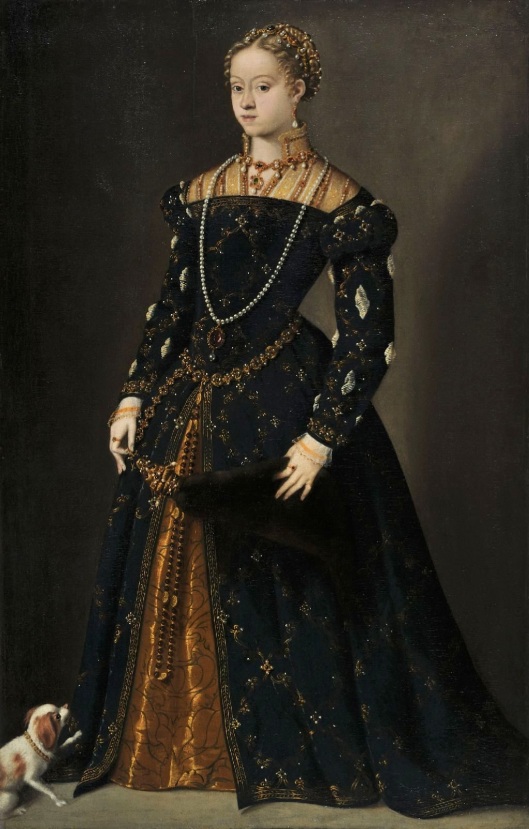Tags
Archduchess Catherine of Austria, Holy Roman Emperor Ferdinand I, House of Jagiellon, Polish–Lithuanian Commonwealth, Queen of Poland, Sigismund II Augustus of Poland
Failed marriage
As Sigismund lost all hope of children by his third bride; he was the last male Jagiellon in the direct line so the dynasty was threatened with extinction. He sought to remedy this by adultery with two of the most beautiful of his countrywomen, Barbara Giza and Anna Zajączkowska but was unable to impregnate either of them.
The Sejm was willing to legitimize, and acknowledge as Sigismund’s successor, any male heir who might be born to him; however, the King remained childless.
In October 1562, at the wedding of Catherine Jagiellon and Duke John of Finland, the couple saw each other for the last time. Catherine lived in Vilnius and Hrodna before being sent to Radom in April 1563. 40-year-old Sigismund sought to obtain annulment of the marriage as he wanted to marry for the fourth time and secure a male heir.
In January 1565, Sigismund complained to papal nuncio Giovanni Francesco Commendone that marriage to Catherine was sinful because she was a sister of his first wife, that she hated Poland, that she caused the miscarriage in 1554, and that he was physically disgusted by his wife due to her epilepsy. Due to Habsburg influence, Pope Pius IV did not allow the divorce.

In July 1564, Ferdinand I, Holy Roman Emperor, died and was succeeded by his son Maximilian II. The new emperor sent his diplomats Andreas Dudith and Wilhelm von Kurzbach to try to reconcile the couple, or if that failed, to convince Sigismund to allow her to leave Poland. The plan for Catherine to leave was discussed in May 1565.
Initially Sigismund refused, fearing that it would only increase the anti-Polish sentiment in the Habsburg court, but later changed his mind because he believed that Catherine’s departure would make it easier to obtain a divorce. In late 1565, she departed to Wieluń, but Polish nobles interfered and her departure to Vienna was delayed until 8 October 1566.
In a letter written to Albert, Duke of Prussia, a day before her departure, Catherine expressed her resolve to one day return to Poland.
Catherine did not receive a warm welcome in Vienna as she was blamed for the failed marriage. Emperor Maximilian II extended her stay and wanted to meet with Sigismund personally to discuss the issue, but he refused.
In March 1567, Andreas Dudith relayed that Sigismund categorically refused to live with Catherine (reportedly, he once said that he would gladly become a monk if that meant he could get rid of Catherine) and that he would not protest if Catherine remained in Austria.
Sigismund would not specify where Catherine should live if she returned to Poland and would not allot money for her court, in effect precluding her from returning. In June 1567, Catherine became seriously ill with what doctors called melancholia. After recovering, in October, she moved to Linz to live out the remaining five years of her life.
According to a witness, Catherine lived like a widow. She received 28,000 guldens annually from Sigismund for her court of more than fifty people. She was visited by her family, she studied the Bible and other theological works, and established a garden for medicinal herbs which produced various herbal remedies. It seems that she still wanted to return to Poland: she tearfully asked Giovanni Francesco Commendone for help when he visited her twice and kept writing letters to her husband. In her last will, she asked her husband for forgiveness and left him all the jewellery she had received from him. The majority of her money was left for charity.
The King’s marriage was a matter of great political import to Protestants and Catholics alike. The Polish Protestants hoped that he would divorce and remarry and thus bring about a breach with Rome at the very crisis of the religious struggle in Poland.
Catherine died on February 28, 1572 and was buried in castle’s chapel. When Rudolf II, Holy Roman Emperor, ordered reconstruction of the castle, her body was moved to the St. Florian Monastery on September 22, 1599. A funeral was not organized until September 22, 1614 during the reign of Emperor Matthias. The surviving sarcophagus was built in 1781.
King Sigismund II Augustus was now free to remarry but he followed Catherine to the grave less than six months later. Sigismund died at his beloved Knyszyn on July 6, 1572, aged 51. After a brief interrex, Henri de Valois of France was elected in the first royal elections as monarch of the Polish–Lithuanian Commonwealth in 1573. However, he soon fled to France after the death of his brother Charles IX of France to inherit the French throne as King Henri III. He was deposed by the Sejm on May 12, 1575 after not returning to Poland. Shortly thereafter, Sigismund’s sister, Anna, was crowned Queen on December 15. She later married Stefan Batory who ruled Poland jure uxoris since May 1, 1576.
